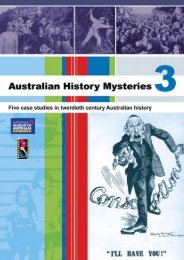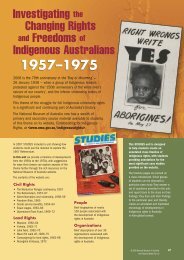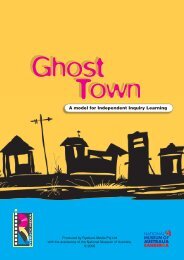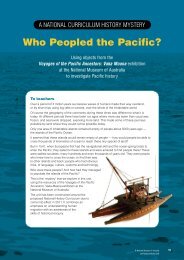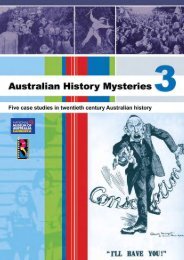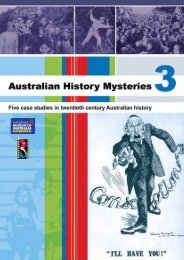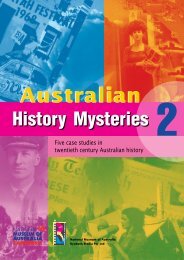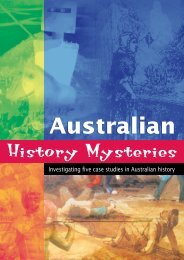Download Teacher Guide & Print Resources - Australian History ...
Download Teacher Guide & Print Resources - Australian History ...
Download Teacher Guide & Print Resources - Australian History ...
You also want an ePaper? Increase the reach of your titles
YUMPU automatically turns print PDFs into web optimized ePapers that Google loves.
Activity page 11A<br />
Were Blaxland, Lawson and Wentworth really the first<br />
Investigation 7 to cross the Blue Mountains?<br />
Everything you have looked at so far in this unit has discussed Blaxland,<br />
Lawson and Wentworth as the first to cross the Blue Mountains.<br />
But, were they?<br />
Some historians have suggested that there might be others who could make<br />
that claim. So, we need to investigate this possibility.<br />
First, let’s be clear what we are looking for. What does ‘crossing’ mean?<br />
1 Here are four possibilities. Discuss each one.<br />
A It means making it all the way to the other side of the mountains.<br />
B It means making it far enough across the mountains to know the<br />
other side is close, but not actually arriving there.<br />
C It means making it far enough across the mountains to suspect<br />
the journey has ended, but not to be certain.<br />
D It means going across the mountains, returning, and creating a<br />
path that others can follow.<br />
Keep these in mind as you look at the following claims. As you read<br />
the information you can follow the different claims on the map on the<br />
next page.<br />
2 As you read the claims, make a short summary note beside each;<br />
for example, This candidate might be considered the first to cross<br />
the Blue Mountains because …<br />
Candidate 2: John Wilson<br />
In 1797, a former convict, John Wilson, recounted tales of his exploits in<br />
the bush to Governor Hunter and Judge Collins. He claimed to have been<br />
upwards of 160 km in every direction around Sydney, and described some of<br />
the landscape and animals he had seen. Whilst his stories were considered<br />
suspect, some details were recorded by Collins. In retrospect, it appears<br />
likely that Wilson was telling the truth.<br />
Wilson appears to have reached the granite country of the upper Cox’s River<br />
valley near Hartley. The two main Aboriginal ‘highways’ were the Bilpin Ridge<br />
from Richmond, and Cox’s River valley from the Burragorang Valley. Other<br />
records offer clues that he followed the Cox’s River route. This is, in fact, the<br />
easiest route through the Blue Mountains, and completely avoids the need<br />
to cross over them. A third possibility is via the Colo River gorge, and some<br />
evidence suggests that Wilson may even have travelled all three!<br />
In January 1798 Wilson, John Price and others crossed the Nepean River<br />
and moved south-west towards the present site of Mittagong. There they<br />
turned west and found a route along the ridge where today the Wombeyan<br />
Caves Road is located. In the process they found a way to go west of the<br />
mountains, by going around them instead of across them. In March of<br />
the same year, Wilson and Price ventured to the Camden area, and then<br />
continued further south until they discovered Thirlmere Lakes, finally almost<br />
reaching the present site of Goulburn.<br />
It is possible that the accomplishments of this expedition were suppressed<br />
by Hunter, who may not have wanted convicts to know that there was a<br />
relatively easy way out of Sydney. Wilson’s life came to an abrupt end at<br />
the age of 30, when he was killed by Aborigines after abducting one of their<br />
women for his personal use.<br />
But, he had accomplished much as an explorer. He was never recognised<br />
as the first person to cross the mountains, possibly because his Cox’s<br />
River journey could not be verified, while his route west of Mittagong may<br />
have been the ‘long way around’ for a colony that had its eyes fixed on the<br />
sandstone fortress west of the Nepean.<br />
http://infobluemountains.net.au/history/crossing_wil.htm<br />
Candidate 1:<br />
Matthew Everingham<br />
See the film<br />
‘virtual visit’<br />
from 05:50 to 08:45<br />
In October/November 1795 Matthew<br />
Everingham, with two other settlers<br />
(William Reed and John Ramsay)<br />
attempted to find a route across the<br />
Blue Mountains.<br />
Working from Everingham’s<br />
description of their journey, local<br />
experts have determined that they<br />
reached either Mt Wilson, Mt Tomah<br />
or Mt Irvine. They reached a point<br />
where they could see good country<br />
to the west but did not proceed any<br />
further as food supplies were running<br />
short. They were not more than one<br />
day’s trek from crossing the Blue<br />
Mountains when they turned back.<br />
This was 18 years before Blaxland,<br />
Lawson and Wentworth finally made<br />
their crossing in 1813.<br />
Their plan to return for a further<br />
attempt never eventuated. To help<br />
prevent the escape of convicts, the<br />
colonial government did not publicise<br />
the possibility of land to the west and<br />
discouraged exploration.<br />
www.firstfleetershunter.com.au/uploads/Family%20<br />
<strong>History</strong>/Matthew%20Everingham.pdf<br />
This candidate might be considered the first<br />
to cross the Blue Mountains because …<br />
This candidate might be considered the first<br />
to cross the Blue Mountains because …<br />
Myths and Mysteries of the Crossing of the Blue Mountains<br />
35




